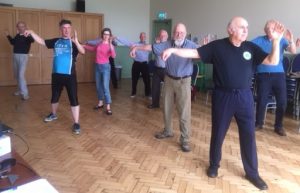Improve Coping with Brain Injury with Mindfulness
By John M. de Castro, Ph.D.
“For many brain injury survivors, mindfulness is an essential practice that helps to regulate their mental health, mood changes, and memory.” – Headway
Brain damage is permanent. The neurons and neural structures that are destroyed when the brain is damaged for the most part do not regrow. Although the brain tissues that are destroyed are permanently lost, we know that people can recover to some extent from brain injury. How is it possible that recovery can occur when there is no replacement of the damaged tissue? There appears to be strategies that are employed by the brain to assist in recovery. Other areas of the brain can take over some of the function, new behavioral strategies can be employed to accomplish the task, and non-injured areas of the brain can adapt and change to compensate for the lost function. Rehabilitation for brain injury patients usually involves strategies to promote these recovery mechanisms. These include mindfulness training which has been found to be helpful in recovery from brain injury.
In today’s Research News article “Grieving a disrupted biography: an interpretative phenomenological analysis exploring barriers to the use of mindfulness after neurological injury or impairment.” (See summary below or view the full text of the study at: https://www.ncbi.nlm.nih.gov/pmc/articles/PMC8386048/ ) Finlay and colleagues recruited adult mindfulness teachers who had a neurological injury including sensory loss. They completed a mindfulness measure and a semi-structured interview exploring their experiences with mindfulness. Transcript of the interviews were assessed for descriptive, linguistic, and conceptual themes.
Two overarching themes emerged in the analysis of the interviews, overcoming a disrupted biography and proactive self-management. The first theme involved adjusting to a new identity and the changed health status and sensory loss. This included coping with their grief over the loss. This was facilitated by mindfulness practices of self-compassion, acceptance, and focusing on the present moment. This heled them to overcome the desire to return to their previous selves, accept themselves as the currently are, and manage their emotions. The second theme of proactive self-management involved using mindfulness practice to regain autonomy and take responsibility for the needed adjustments to their lives. This involved not diffusing responsibility to healthcare providers. It also involved using mindfulness to manage the physical and emotional suffering resulting from the injury including pain and emotional agony.
It was clear from the participants descriptions of their journeys to adapt to their changed realities that the adaptations were greatly facilitated by mindfulness practice. It allowed them to accept things as they are and take responsibility for their own management of the symptoms. The study involved highly experienced mindfulness practitioners. It is not clear that training in mindfulness after neurological injury in non-practitioners would have the same benefits. But the descriptions revealed that the core skills produced by mindfulness training were essential in accepting and adjusting to their altered selves. So, it would be expected that mindfulness training would be beneficial to everyone after neurological injury.
So, improve coping with brain injury with mindfulness.
“TBI is a complex diagnosis involving many components. One significant component is the stress response after having this type of injury. Mindfulness meditation appears to have a strong relaxing and stress reduction quality for patients, which is tremendously beneficial for overall recovery from injury.” – Heechin Chae
CMCS – Center for Mindfulness and Contemplative Studies
This and other Contemplative Studies posts are also available on Google+ https://plus.google.com/106784388191201299496/posts and on Twitter @MindfulResearch
Study Summary
Finlay, K. A., Hearn, J. H., & Chater, A. (2021). Grieving a disrupted biography: an interpretative phenomenological analysis exploring barriers to the use of mindfulness after neurological injury or impairment. BMC psychology, 9(1), 124. https://doi.org/10.1186/s40359-021-00628-0
Abstract
Background
Mindfulness has demonstrated strong utility for enhancing self-management and health outcomes in chronic illness. However, sensation-focused mindfulness techniques may not be appropriate for clinical populations with neurological injury. This study aimed to identify how expert mindfulness teachers with sensory loss/impairment naturalistically adapt and experience mindfulness. We aimed to highlight the rationale for and barriers to mindfulness practice when living with sensory loss.
Methods
A qualitative, semi-structured interview design was used, analysed via Interpretative Phenomenological Analysis (IPA). Eight (5 females, 3 males) mindfulness teachers with neurological injury were recruited via a national registry of Mindfulness for Health teachers. Interviews (range: 50–93 min) were completed, transcribed verbatim and analysed idiographically for descriptive, linguistic and conceptual themes, before a cross-case analysis was completed.
Results
Two superordinate themes were identified: (1) Overcoming a disrupted biography; and (2) Proactive self-management. These themes considered the challenge of reconciling, through grief, a past health status with the present reality of living with sensory loss due to Spinal Cord Injury, Multiple Sclerosis or Functional Neurological Disorder. Mindfulness was experienced as a method by which proactive choices could be made to maintain control and autonomy in health, reducing perceptions of suffering, psychological distress, cognitive reactivity and rumination.
Conclusions
Mindfulness was found to support the self-management of health after neurological injury/impairment. Mindfulness meditation presented an initial challenge as trauma and grief processes were (re-)activated during mindfulness sessions. However, mindfulness was found to support the resolution of these grief processes and encourage adaptive approach-based coping and acceptance of health and neurological impairment/injury.
https://www.ncbi.nlm.nih.gov/pmc/articles/PMC8386048/









